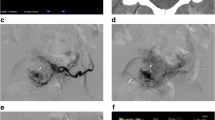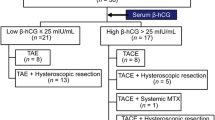Abstract
Objective
To evaluate the neovascularization in placental polyp tissue by computed tomographic angiography and to determine the need for uterine artery embolization before hysteroscopic resection.
Study design
Seventeen consecutive women with suspected placental polyp were enrolled in this retrospective study. Neovascularization in placental polyp tissue was assessed by computed tomographic angiography. Cases with neovascularization were treated by hysteroscopic resection with preoperative uterine artery embolization, while cases without neovascularization were treated by hysteroscopic resection alone.
Results
Of 17 patients with suspected placental polyp after abortion or parturition, nine patients were diagnosed to have placental polyp with prominent neovascularization by computed tomographic angiography, and were treated by uterine artery embolization followed by hysteroscopic resection. Two patients subsequently conceived after conservative management.
Conclusions
After precise evaluation of neovascularization by computed tomographic angiography, hysteroscopic resection with preoperative uterine artery embolization is an effective minimally invasive procedure to conservatively treat placental polyp with prominent neovascularization.


Similar content being viewed by others
References
Swan RW, Woodruff JD (1969) Retained products of conception: histologic viability of placental polyps. Obstet Gynecol 34:506–514
Dyer I, Bradburn DM (1971) An inquiry into the etiology of placental polyps. Am J Obstet Gynecol 109:858–867
Kurachi H, Maeda T, Murakami T, Tsuda K, Sakata M, Nakamura H, Miyake A (1995) MRI of placental polyps. J Comput Assist Tomogr 19:444–448
Noonan JB, Coakley FV, Qayyum A, Yeh BM, Wu L, Chen L (2003) MR imaging of retained products of conception. Am J Roentgenol 181:435–439
Sadan O, Golan A, Girtler O, Lurie S, Debby A, Sagiv R, Evron S, Glezerman M (2004) Role of sonography in the diagnosis of retained products of conception. J Ultrasound Med 23:371–374
Durfee SM, Frates MC, Luong A, Benson CB (2005) The sonographic and color Doppler features of retained products of conception. J Ultrasound Med 24:1181–1186
Greenberg JA, Miner JD, O’Horo SK (2006) Uterine artery embolization and hysteroscopic resection to treat retained placenta accreta: a case report. J Minim Invasive Gynecol 13:342–344
Hatfield JL, Brumsted JR, Cooper BC (2006) Conservative treatment of placenta accreta. J Minim Invasive Gynecol 13:510–513
Takeuchi K, Sugimoto M, Kitao K, Yoshida S, Maruo T (2007) Pregnancy outcome of uterine arterial embolization followed by selective hysteroscopic removal of a placental polyp. Acta Obstet Gynecol Scand 86:22–25
Jiménez JS, Gonzalez C, Alvarez C, Muñoz L, Pérez C, Muñoz JL (2009) Conservative management of retained trophoblastic tissue and placental polyp with diagnostic ambulatory hysteroscopy. Eur J Obstet Gynecol Reprod Biol. doi:10.1016/j.ejogrb.2009.04.001 (in press)
Takeda A, Koyama K, Mori M, Sakai K, Mitsui T, Nakamura H (2008) Diagnostic computed tomographic angiography and therapeutic emergent transcatheter arterial embolization for management of postoperative hemorrhage after gynecologic laparoscopic surgery. J Minim Invasive Gynecol 15:332–341
Takeda A, Koyama K, Imoto S, Mori M, Sakai K, Nakamura H. Progressive formation of uterine arteriovenous fistula after laparoscopic-assisted myomectomy Arch Gynecol Obstet. doi: 10.1007/s00404-009-0981-8 (in press)
Takeda A, Manabe S, Hosono S, Nakamura H (2004) Preoperative evaluation of submucosal myoma by virtual hysteroscopy. J Am Assoc Gynecol Laparosc 11:404–409
Kido A, Togashi K, Koyama T, Ito H, Tatsumi K, Fujii S, Konishi J (2003) Retained products of conception masquerading as acquired arteriovenous malformation. J Comput Assist Tomogr 27:88–92
Conflict of interest statement
None.
Author information
Authors and Affiliations
Corresponding author
Rights and permissions
About this article
Cite this article
Takeda, A., Koyama, K., Imoto, S. et al. Computed tomographic angiography in diagnosis and management of placental polyp with neovascularization. Arch Gynecol Obstet 281, 823–828 (2010). https://doi.org/10.1007/s00404-009-1161-6
Received:
Accepted:
Published:
Issue Date:
DOI: https://doi.org/10.1007/s00404-009-1161-6




